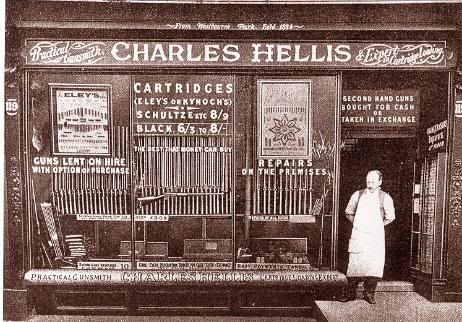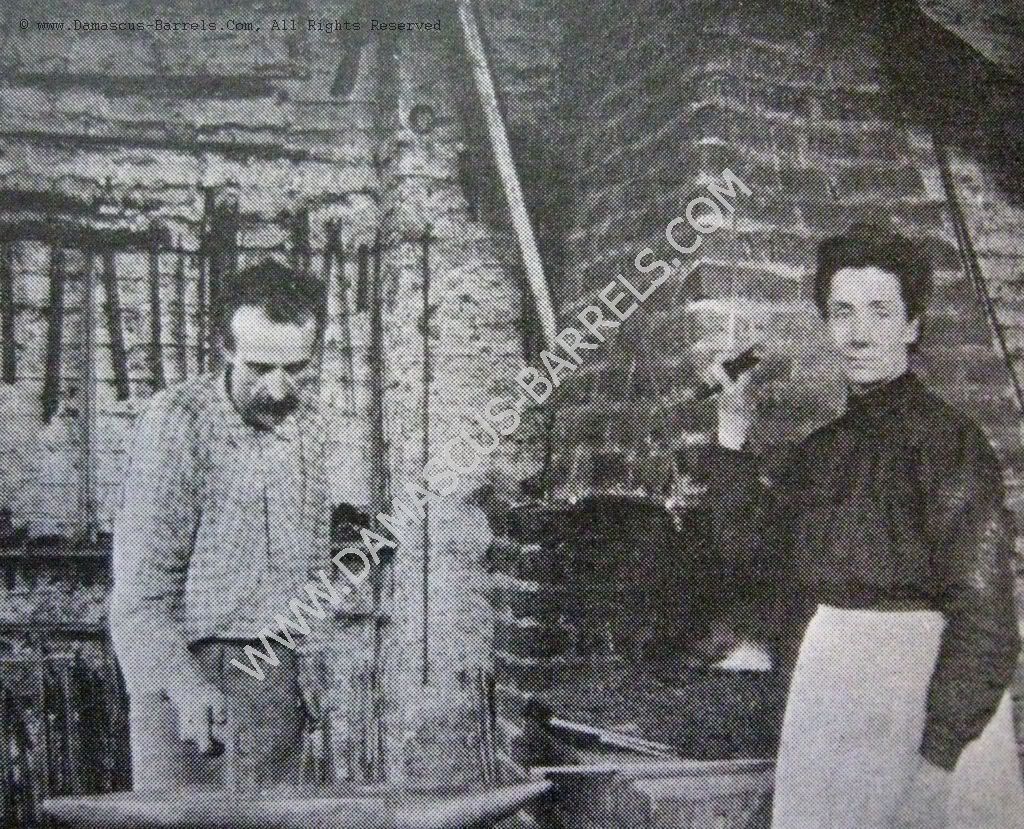|
S |
M |
T |
W |
T |
F |
S |
|
|
|
|
|
|
|
1
|
|
2
|
3
|
4
|
5
|
6
|
7
|
8
|
|
9
|
10
|
11
|
12
|
13
|
14
|
15
|
|
16
|
17
|
18
|
19
|
20
|
21
|
22
|
|
23
|
24
|
25
|
26
|
27
|
28
|
29
|
|
30
|
|
|
|
|
|
|
|
|
Forums10
Topics39,607
Posts563,352
Members14,600
| |
Most Online9,918
Jul 28th, 2025
|
|
|
|
Joined: Aug 2007
Posts: 12,135 Likes: 420
Sidelock
|

Sidelock
Joined: Aug 2007
Posts: 12,135 Likes: 420 |
About the time of the German proof rules were enacted in 1893, makers in Suhl started a voluntary night school which was about 6 hours per week. Being the same time period of the 1st proof rules might be happenstance or not, but due to the fractured nature of the manufacturing of military arms in the Suhl area, the Germany command established facilites at Danzig, Erfurt, Spandau/Potsdam and Amberg, Bavaria to ensure production while the majority of makers in Suhl migrated toward sporting arms. There wasn't an arsenal near Suhl and that aided in the crossover, unlike Herzberg and Vejprty/Weipert where the military aspect along with Vjperty/Weipert's resistance to convert to mechanization pretty much killed the individual craftsmen and one started to see sourcing to Suhl.
But in 1910 a Technical College was founded in Suhl and the student spent 1/2 a day for 3 days a week in mathematics, gun design and the like.
Kind Regards,
Raimey
rse
Last edited by ellenbr; 06/10/09 09:43 AM.
|
|
|
|
|
Joined: Jun 2004
Posts: 349
Sidelock
|

Sidelock
Joined: Jun 2004
Posts: 349 |
Apparently the apprenticeship in England had been 7 years at one point: The King and Company Of Gunmakers. 1733-1734
J Mandamus.
Mandamus to admit J.S. to his Freedom of the Gunmakers Company, having been educated in the Art and Mystery of a Gunsmith, and served seven Years Apprenticeship. The Company returned they were incorporated by Charter, by Char. 1, and set out the Charter, that no Person was intitled to his Freedom but those of the Trade residing in London, or within ten Miles thereof at Time of the Incorporation, and such of their Children as should serve seven Years Apprenticeship to that Art and Mystery ; and as to other Persons it left the Company at large to admit or reject as they thought proper and convenient, and they returned that they did not think proper to admit him. Objection was taken to the Return, that it did not answer the Suggestion, as to his being educated in the Art, etc., and serving seven Years Apprenticeship. Pete Pete, That is an interesting quote. The applicant JS must have been a pushy fellow by trying the mandamus route to gain entry to the Company. He must have had a good patron or two to think it worthwhile. However, it would seem that he had poor grounds for doing so, particularly as he did not provide much evidence or proper responses to their queries, as evidenced by their closing sentence, “Objection was taken to the Return, it did not answer the Suggestion, as to his being educated in the Art, etc., and serving seven Years Apprenticeship.”In Ireland now it is 2 years for solicitors; apprentices must have passed various law exams first, then do a two-year stint with a master before sitting final exams and being admitted to practice. AFAIK, the payment to the master has stopped and the apprentices are paid the minimum wage – about $450 a week. Apprenticeships are the entrypath to the main trades – see the national training body’s site for details on http://www.fas.ie/en/Training/Apprenticeships/default.htm Rs K.
|
|
|
|
|
Joined: Nov 2005
Posts: 4,598
Sidelock
|
OP

Sidelock
Joined: Nov 2005
Posts: 4,598 |
 Apprenticeship training in France, late 1800's http://books.google.com/books?id=WadJAAAAMAAJ&pg=PA255&dq=gunsmith+apprenticeship&lr=Apparently France had established technical schools well in advance of Belgium and many other countries. A school was founded in Reims in 1875. The apprenticeship lasted 3 years, without pay. Gunsmith apprentice had to learn the forge and fitting, then was able to choose gunsmith as a speciality. If a student graduated in good standing, he was given a set of tools. Apprenticeship training in Quebec, 1700's http://books.google.com/books?id=IOG6fyobIf8C&pg=PA180&dq=gunsmith+apprenticeship&lr=The Canadians entered into a contractual arrangement that lasted 3 years. The Canadian apprentice was paid. Apprenticeship in Colonial New York. http://books.google.com/books?id=eJIVAAAAIAAJ&pg=PA91&dq=gunsmith+apprenticeship&lr=While not a gunsmith contract, this is still interesting... This Indenture Witnesseth that John Campbel'Son of Robert Campbell of the City of New York with the Consent of his father and mother hath put himself and by these presents doth Voluntarily put and bind himself Apprentice to George Brownell of the Same City Schoolmaster to learn the Art Trade or Mystery . . . for and during the term of ten years. . . . And the said George Brownell Doth hereby Covenant and Promise to teach and Instruct or Cause the said Apprentice to be taught and Instructed in the Art Trade or Calling of a Schoolmaster by the best way or means he or his wife may or can. So, an apprentice was considered an indentured servant and subject to the laws relating to indenture and Poor Law. Pete
|
|
|
|
|
Joined: Aug 2007
Posts: 12,135 Likes: 420
Sidelock
|

Sidelock
Joined: Aug 2007
Posts: 12,135 Likes: 420 |
Any of you fellas who are students of the British gun-trade know if there were ever any female master-gunsmiths? Or have any info on women in the gun-trade, other than in Belgium?
Kind Regards,
Raimey
rse
|
|
|
|
|
Joined: Jun 2004
Posts: 349
Sidelock
|

Sidelock
Joined: Jun 2004
Posts: 349 |
Interesting question. Out-work on stock/wood scratching?
Have you tried looking in the history of women in guilds? Some guilds "tolerated" women, particularly those who carried on a deceased husband's business, and allowed them membership but no voting rights in the running of the guild. British occupational surnames ending in -ster (spinster) denote descent of the name from a female involved in the trade e.g. Webster, Brewster, Baxter (Baker)
Rs
K.
|
|
|
|
|
Joined: Aug 2007
Posts: 12,135 Likes: 420
Sidelock
|

Sidelock
Joined: Aug 2007
Posts: 12,135 Likes: 420 |
Thanks for the suggestions. I have read of widows and daughters working in the business. Post war there were families where the man was a gunsmith while the wife was an engraver. But I haven't found any info that suggests the wife completed an apprentice program, but it may be implied.
Kind Regards,
Raimey
rse
|
|
|
|
|
Joined: Nov 2006
Posts: 617 Likes: 1
Sidelock
|

Sidelock
Joined: Nov 2006
Posts: 617 Likes: 1 |
Raimey,considering the postion of women in society during the vintage gun period, I don't think you'll find any females in the roles of apprentices or master craftsmen,especially in England.
Justin
|
|
|
|
|
Joined: Nov 2005
Posts: 4,598
Sidelock
|
OP

Sidelock
Joined: Nov 2005
Posts: 4,598 |
1901 English Census. Mary Golcher, sister to James and Joseph Golcher.  Pete
|
|
|
|
|
Joined: Nov 2006
Posts: 617 Likes: 1
Sidelock
|

Sidelock
Joined: Nov 2006
Posts: 617 Likes: 1 |
WOW,that setles that incorrect assumption of mine.
Thanks Pete
Justin
|
|
|
|
|
Joined: Nov 2005
Posts: 4,598
Sidelock
|
OP

Sidelock
Joined: Nov 2005
Posts: 4,598 |
The Golcher's started as nail makers. For some reason, many early nail makers became associated with the gun trade. Her grand-uncle (??) John Golcher was a gun maker in Philadelphia during the revolutionary war. http://books.google.com/books?id=kJ1uAAAAMAAJ&pg=RA3-PA7&dq=john+golcher+philadelphiaHer father, William Golcher had a lock making business in the early 1800's in England. Her brother Joseph stayed in England and ran the business, while her brother James came to Philadelphia. Two of his sons are well known here, William Golcher and Thomas L Golcher. The family continued in the gun trade here until 1949. Her son, Thomas, was killed during WWI while driving an ambulance in France. What Mary's exact role was in the family business is unclear. I can find no record of her ever getting married, even though the census lists her as widowed. Justin, I would have assumed the same, except for my research, which points to examples like this. I believe there are other examples of woman, whose husband's owned a business or patent, continuing to run the business after the death of their spouse. I am hard pressed at the moment to give exact names. Whether Mary ever was accepted by the guild may never be known. There were also many woman in Belgium who were employed as out workers and factory workers by the trade.  Pete
|
|
|
|
|